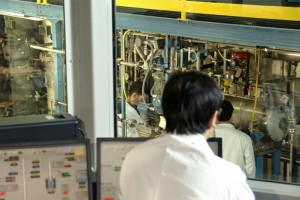A noticeable focus on increasing C3, C4 and C5 olefins production seems to be emerging as higher alkylate volumes are needed for the unexpected growth in gasoline demand, as previously discussed in Refinery Operations. Gasoline prices approaching $1.50 per gallon (and even lower) has many motorists switching to high octane premium gasoline. With a tight octane market expected by summer 2016, incentives are for expanding alkylation are supported by plentiful NGL feedstocks.
C4 olefins in particular are favored because of the high quality alkylate produced relative to C3 and C5 olefins, or even mixtures of C4 and C5 olefins. At the previous AFPM Cat Cracking Seminar in Houston, Tesoro’s Herb Telidetzki, FCC/alkylation specialist, noted that the cost of operating a C4 based alkylation unit was lower vs a C3 based unit.
Noting this development, FCC catalyst suppliers are adjusting ZSM-5 based catalyst formulations to boost C4 olefins production. With “standard” ZSM-5 formulations, refiners would expect to see about 60% propylene and 30% butylenes off the LPG fed FCC unit, noted Telidetzki. Efforts to improve butylenes selectivity has revolved around reducing FCC catalyst rare earth content. “In addition, increased riser temperature can help shift the butylenes to propylene ratio in favor of butylenes, while a reduction in preheat temperature and increased catalyst-to-oil ratio at the same riser temperature increases propylene yield,” noted Telidetzki (while referencing a “selectivity to butylene” chart supplied by Grace Catalyst Technologies).
Other considerations, such as limiting sodium (Na) content to the lowest possible amount on FCC catalyst has a big impact on C4 olefin generation, according to other comments made at the AFPM Cat Cracking conference.
In any event, C3, C4 and C5 olefins are relatively cheap, while their propane, butane and pentane precursors are plentiful. Some refiners, such as Valero, have announced plans to convert an existing C4 olefins-based alkylation unit to a 13,000 bpd C5 olefins (amylenes) alkylation unit at the Valero Houston refinery for a cost of $300 million (startup: mid-2019). In their recent 4Q 2015 earnings report released in late January, a Valero executive said he expects to see strong alkylate demand in the summer of 2016. They had studied expanding existing catalytic reforming capacity, but instead noted that “the alky project showed a better outcome.”
Besides, Valero executives noted the C4 alky project also serves as a way to move plentiful NGLs into the gasoline pool. This goes without saying that MarkWest Energy Partners LP, the biggest natural gas processor and fractionators in the Utica and Marcellus shale plays, is planning on building an alkylation unit, apparently to facilitate movement of NGLs into the gasoline pool. This would be a “midstream” NGL pipeline-advantaged stand-alone alkylation unit, 60 miles away from the nearest refinery.








Leave a Reply
You must be logged in to post a comment.